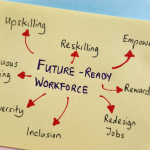Executive Summary
-
Explore how a prominent financial institution successfully integrated a remote workforce.
-
Understand the key strategies and tools utilized in the transition.
-
Learn about the benefits and challenges faced during the integration process.
-
Gain insights on best practices for maintaining productivity and compliance in a remote setup.
-
Discover expert recommendations for other institutions considering a similar shift.
Introduction
In today’s rapidly evolving digital landscape, the ability to adapt to remote work has become a crucial factor for business continuity and growth. For financial institutions, this transition poses unique challenges due to regulatory demands and data security concerns. This article delves into the journey of a leading financial institution in achieving seamless remote workforce integration. You will learn about the strategies they employed, the obstacles they overcame, and the lessons they uncovered, offering valuable insights for any business contemplating a similar shift.
Definitions / Context
Understanding remote workforce integration involves several key concepts:
-
Remote Workforce Integration: The process of transitioning traditional office-based roles to remote settings while maintaining operational efficiency and compliance.
-
Digital Collaboration Tools: Software platforms that facilitate communication and collaboration among team members in different locations.
-
Data Compliance: Adhering to industry regulations to protect client and institutional data, crucial in financial sectors.
Benefits / Pros
-
Increased Flexibility: Employees can work from anywhere, leading to higher job satisfaction.
-
Cost Savings: Reduced overhead costs from office space and utilities.
-
Wider Talent Pool: Ability to hire talent from different geographical locations.
-
Business Continuity: Enhanced resilience against disruptions like pandemics or natural disasters.
Risks / Cons / Challenges
-
Data Security: Ensuring secure data transmission and storage remains a top priority.
-
Regulatory Compliance: Meeting stringent financial regulations can be challenging in a remote setup.
-
Employee Isolation: Potential for reduced team cohesion and morale.
-
Technological Barriers: Adequate infrastructure required for seamless remote operations.
Step-by-Step Process
Steps for Seamless Remote Workforce Integration:
-
Assessment and Planning: Evaluate the current workforce and identify roles suitable for remote work.
-
Infrastructure Setup: Invest in secure VPNs, cloud storage, and collaboration tools.
-
Policy Development: Create clear remote work policies and guidelines.
-
Training and Support: Provide training on new tools and maintain ongoing IT support.
-
Performance Monitoring: Establish metrics and tools for tracking productivity.
The financial institution, XYZ Bank, embarked on its remote integration journey in 2020. By leveraging cloud-based platforms like Microsoft Teams and robust cybersecurity measures, they ensured uninterrupted service delivery. The transition resulted in a 20% reduction in operational costs and a 15% increase in employee satisfaction, illustrating the potential benefits of a well-executed remote work strategy.
Case Study: XYZ Bank
Expert Tips / Strategic Insights
-
Epiidosis Recommends: Regularly update cybersecurity protocols to address emerging threats.
-
Foster a culture of communication to combat feelings of isolation.
-
Implement a hybrid model to combine the benefits of both remote and in-office work.
Tools / Resources / Calculators
-
Remote Work Readiness Checklist: Assess your organization’s readiness for remote work.
-
Security Compliance Estimator: Estimate the resources needed to maintain compliance.
-
Collaboration Tool Comparison Guide: Compare tools like Slack, Zoom, and Microsoft Teams.
Conclusion
The case of XYZ Bank demonstrates that with thoughtful planning and execution, financial institutions can successfully transition to a remote workforce without compromising on efficiency or compliance. As remote work continues to gain traction, businesses must prioritize strategic planning to reap the benefits and mitigate potential risks. For tailored guidance on transitioning your workforce, consult with our experts.























